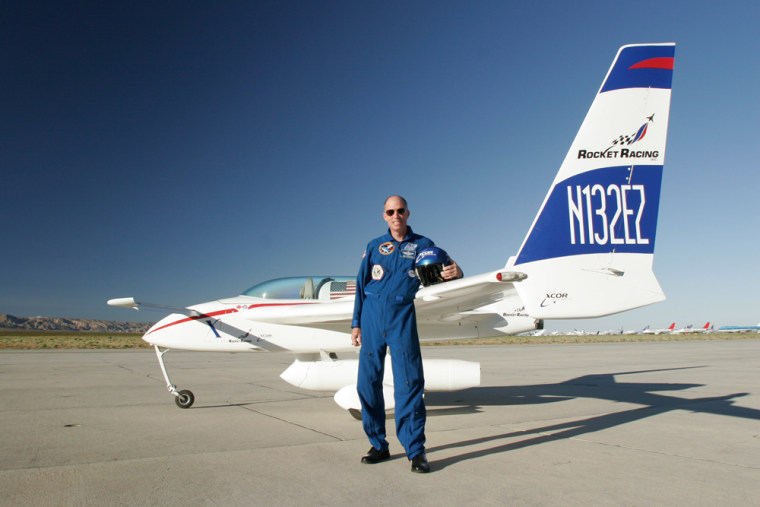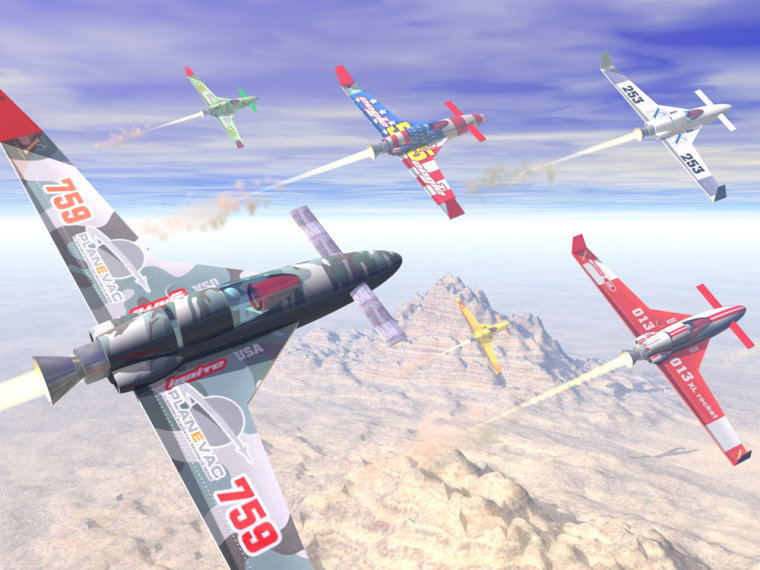The man behind the $10 million X Prize for private spaceflight is joining forces with a venture capitalist who's also an Indy car backer to establish a NASCAR-like racing league for rocket-powered aircraft.
X Prize founder Peter Diamandis and race car capitalist Granger Whitelaw took the wraps off the Rocket Racing League during a Monday news conference, just days before a rocket plane demonstration that could serve as a model for the races.
Next weekend's flights by XCOR Aerospace's EZ-Rocket are to take place as part of the Countdown to the X Prize Cup exposition in Las Cruces, N.M. — the kickoff to an annual rocket festival designed to follow up on the momentum generated by the original prize.
For years, Diamandis has pointed to NASCAR's success as something he wanted to emulate in spaceflight, and he touted the X Prize Cup as a competition that could fill that role. The Rocket Racing League would organize competitions around the United States, with the finals taking place at the X Prize Cup in New Mexico.
"It's bringing 21st-century racing into people's personal living rooms. ... It's really the mix of NASCAR excitement and spaceflight," Diamandis told journalists Monday.
Contestants in the Rocket Racing League would not necessarily pass the 62-mile-high (100-kilometer-high) threshold to outer space, but would vie to go the fastest and the highest in the atmosphere. In that regard, the EZ-Rocket — a rocket plane powered by liquid oxygen and isopropyl alcohol that takes off and lands like an airplane — provides a better model than, say, the air-launched SpaceShipOne rocket plane that won the X Prize almost exactly a year ago.
"For me, it's sort of a remembrance of 'Star Wars' pod racing," Diamandis said.
‘Fire-breathing dragons’The first rocket racers would be built by XCOR, with a second generation based on an airframe provided by Velocity Aircraft of Sebastian, Fla., the league said in a . Individual teams would own the racers and be able to customize them.
Diamandis said the souped-up racers would burn kerosene fuel rather than alcohol. "These vehicles will literally sport a 20-foot bright brilliant flame out the back," he said.

He asked journalists to imagine "10 of these fire-breathing dragons" racing in competition.
Whitelaw traveled to Mojave last month to watch an EZ-Rocket test flight and said the experience "really blew me away."
"It is nothing like NASCAR or Indy car," he told the journalists. "It is 10 times louder."
In Monday's statement, the Rocket Racing League said the races would operate much like auto races, "with the exception that the 'track' is up in the sky."
"Courses are expected to be approximately two miles long, one mile wide, and about 5,000 feet high, running perpendicularly to spectators," the league said. "The rocket planes, called X-Racers, will take off from a runway both in a staggered fashion and side-by side and fly a course based on the design of a Grand Prix competition, with long straightaways, vertical ascents, and deep banks. Each pilot will follow his or her own virtual 'tunnel' or 'track' of space through which to fly, safely separated from their competitors by a few hundred feet."
Speeds of 200 to 300 mphDiamandis said the rockets would fly at speeds of 200 to 300 mph (320 to 480 kilometers per hour). Spectators could be provided with palm-size computer displays to follow the competitors, Whitelaw said.
Viewers at home could watch the racers zoom neck-and-neck on a video overlay. That's a bit of TV trickery analogous to Dartfish's "SimulCam" technology for sports ranging from auto racing to track and field.
Whitelaw said the detailed rules and specifications for the league were still being drawn up. Financial arrangements — including sponsorships — were also pending, he said. "We're initiating talks right now with some of the major channels" about a TV deal, he said.
He said the first league finals would take place in October 2006, with four rockets competing in the debut. The field would expand to 10 rocket planes in 2007, he said, and video games based on the competition also would make their debut in that time frame.
A concept’s second stage
The idea of racing rockets isn't exactly new: In fact, the California-based EZ-Rocket last took its show on the road in 2002 for a demonstration at the EAA AirVenture show in Oshkosh, Wisconsin, with support from a fledgling organization called the Experimental Rocket Racing Association, or X-Rocket.
Although X-Rocket is no longer active, Diamandis and Whitelaw hope that their funding and familiarity with racing and rocketships will help their venture achieve cruising altitude.
Diamandis, the league's chairman, is not only the founder and chairman of the X Prize Foundation, but the founder and chairman of Zero Gravity Corp., which offers weightless-simulation flights on converted cargo jets; and a co-founder of Space Adventures, the tourism company that arranged this week's trip to the international space station by New Jersey millionaire scientist Greg Olsen.
Whitelaw, the league's president, has been involved in Indy car racing over the past decade, as a partner in two winning Indy 500 teams as well as a race organizer. He is the founding partner and managing director of BlueCar Partners, a venture-consulting firm, and has been involved in businesses ranging from virtual offshore banking to fashion publications to movie production. (His name has also shown up in the New York Post's gossip column.)
Rocket regulation
In addition to the financial hurdles, the rocket league would have to be cleared for takeoff by the Federal Aviation Administration. Patricia Grace Smith, the FAA's associate administrator for commercial space transportation, indicated at the news conference that the league would get a sympathetic hearing.
"We're here because we see this as another means of making rocket flight more tangible to the public. This is an opportunity to introduce the power and thrill of rockets in the form of high-velocity entertainment," Smith said. "Today's announcement resurrects the great American tradition of air racing, wraps it in the technology of the 21st century, and gives the nation a thrilling glimpse of things to come, thanks to Peter Diamandis and Granger Whitelaw. The Rocket Racing League is an atmospheric showcase for the kind of rocket technology that will evolve in time from spectator sport to citizen suborbital spaceflight."
She told journalists that the FAA "stands ready to enable this business through an efficient and responsive regulatory approach."
Diamandis indicated that the rocket planes involved in the racing league would operate under experimental airworthiness certificates, as the EZ-Rocket has in the past.
